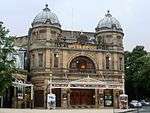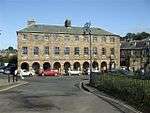Grade II* listed buildings in High Peak
There are over 20,000 Grade II* listed buildings in England. This page is a list of these buildings in the district of High Peak in Derbyshire.
List of buildings
See also
- Grade I listed buildings in Derbyshire
- Grade II* listed buildings in Amber Valley
- Grade II* listed buildings in Bolsover (district)
- Grade II* listed buildings in Chesterfield
- Grade II* listed buildings in Derby
- Grade II* listed buildings in Derbyshire Dales
- Grade II* listed buildings in Erewash
- Grade II* listed buildings in North East Derbyshire
- Grade II* listed buildings in South Derbyshire
- Listed buildings in New Mills
Notes
- ↑ The date given is the date used by Historic England as significant for the initial building or that of an important part in the structure's description.
- ↑ Sometimes known as OSGB36, the grid reference is based on the British national grid reference system used by the Ordnance Survey.
- ↑ The "List Entry Number" is a unique number assigned to each listed building and scheduled monument by Historic England.
External links
![]() Media related to Grade II* listed buildings in Derbyshire at Wikimedia Commons
Media related to Grade II* listed buildings in Derbyshire at Wikimedia Commons
This article is issued from Wikipedia - version of the 4/12/2015. The text is available under the Creative Commons Attribution/Share Alike but additional terms may apply for the media files.















